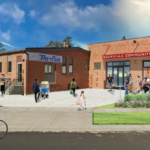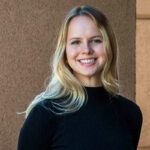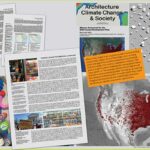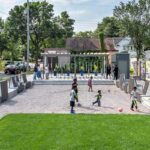Students Working with Faculty
The SURF grant, Support for Undergraduate Research Fellows, is a University grant awarded to student researchers to participate on faculty research projects. Faculty in the Department of Architecture have been very successful in obtaining SURF grants.
This program is designed to foster faculty-student research collaborations, and, as such, the UWM Office of Undergraduate Research (OUR) is particularly eager to fund work through which students have the opportunity to engage in thoughtful and progressively sophisticated work central to the overall research program of the principal investigator. SURF awards are part of larger efforts to foster a culture of faculty-undergraduate research collaboration at UWM.
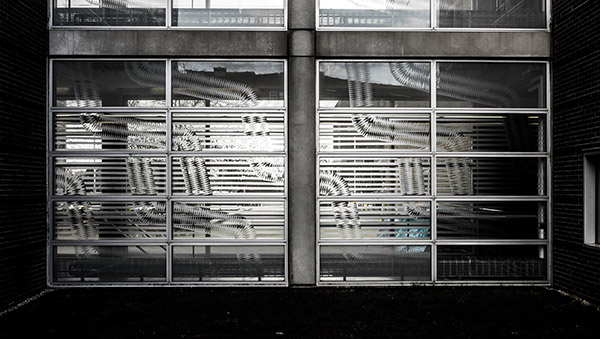
Taught by Assistant Professor Kyle Reynolds
SURF and RACAS Grants
Every year there are between 365 million and a billion bird deaths in North America that are caused by collisions with buildings. Many of the species involved are migratory birds whose survival is already threatened due to habitat loss and climate change. These unnecessary deaths exert a significant toll on state and national economies linked to tourism and agriculture as well as contributing to the degradation of our environment.
Architecture for the Birds is a collaborative project between SARUP and the Department of Geography. It consists of three overlapping initiatives that deal with bird-strikes, prevention, monitoring, and building retrofit. A UWM SURF grant was awarded to Assistant Professor Filip Tejchman for work with design students on this project. The SURF grant—Support for Undergraduate Research Fellows—is a university grant awarded to student researchers to participate on faculty research projects.
The prevention phase was kicked-off in the fall of 2016. Professor Glen Fredlund in the Department of Geography has conducted campus surveys of bird-deaths for the past several years and identified a portion of the SARUP building that is particularly lethal to birds. With the help of Assistant Professor Kyle Reynolds, Tejchman and the students who were enrolled in Arch 281 used this location information as the basis for organizing a student design competition to create a pattern for the windows using a reflective window tape. The winner of this competition, Asal Abdel Issa, further developed her proposal in collaboration with Jackson Leverenz and Collin Tanner. The results of the competition were featured in the UWM Research Journal and presented at the Annual Mid-Western Bird Conservation Initiative Conference and the UWM Water Policy Institute Symposium.
Building on the work done as part of the SURF grant, the project was awarded a Research and Creative Activities Support (RACAS) grant to further refine a low-cost sensor system. This is a product-oriented development project that is based on the ethos of the “internet of things” as applied to the relationship between buildings and the numerous ambient and animal flows that pass through and around them. Additional assistance for this project is being provided by a consortium that includes the American Bird Conservancy, Western Great Lakes Bird and Bat Observatory, and Bird City Wisconsin.
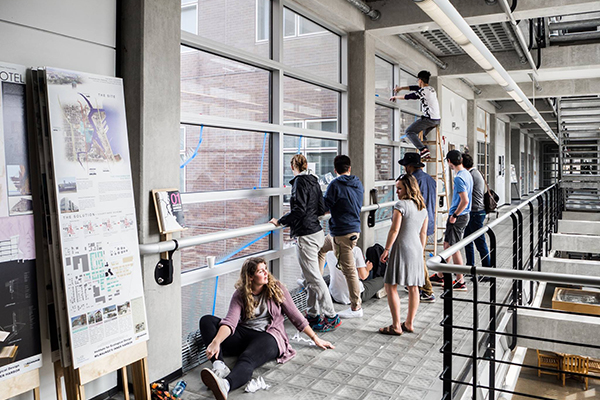
Students work on installation of the developed window patterns
Whitney Moon & Adam Oknin
Inflatable Pavilion
Pnome is a lightweight and mobile inflatable pavilion that is designed for recreational purposes as well as for outdoor seminars. The double-curved surface of the biomimetic form encompasses occupants with pillow-like cushions that are intended to stimulate a tranquil environment. In addition, the double-membrane envelope is fabricated out of rip stop nylon, a highly durable and water-resistant material that keeps the elements from percolating inside and prevents tears from expanding. Along with the added internal air pressure and ground anchors, the envelope is seamed together with a tensile ribbon structure that is devised to be wind resistant.
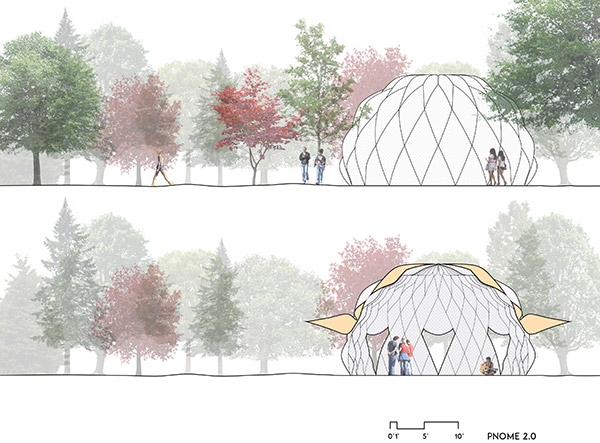
Mo Zell & Jonnie Nelson
Lighting installation for Waterford, WI
At the juncture of the Fox River and Main Street sits the heart of downtown Waterford. Recent bridge and roadway proposals by the WDOT turn this critical intersection into a high speed, regional through route. Five different reports commissioned by Waterford point out that Waterford needs to increase the connection between downtown and the river.
To address this missed opportunity a collaboration between the Village, Racine Arts Museum, UWM School of Architecture and Urban Planning, HARK design collaborative, and Racine Arts Council, along with many community partners, has worked together to transform the river into a new main street with three public light installations and community programming built around the installations.
In collaboration with Associate Professor Mo Zell, undergraduate researcher Jonnie Nelson tested illumination qualities relative to various light tube forms using 3D printed models. The tubes will contain LED lights and will be suspended over the Fox River in Waterford, creating a visual identity for the community. All 3D prints were made in the SARUP Rapid Prototyping Lab.
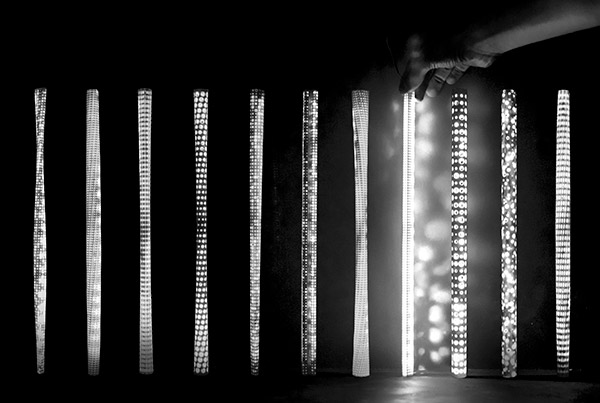
Arijit Sen & Mia Krantz
Engaging stakeholders
Associate Professor Arijit Sen led the 2016 summer BLC field school in Washington Park. The Buildings-Landscapes-Cultures Field School is a unique curricular offering at UWM’s Department of Architecture. It is a multi disciplinary setting where students, faculty, scholars, and community members explore ways to see and interpret the city by engaging multiple urban stakeholders in storytelling, ecological conservation, heritage preservation and civic engagement. From Grace Lee Boggs we learned that “We are the leaders we’ve been looking for,” and the job at the BLC field school is to empower such leaders. The specific objective of this project is to 1) encourage community-based learning and collaboration, 2) collect local histories of places of cultural relevance 3) gain skills that allow professionals to collect and analyze data 4) use the power of digital humanities to disseminate research data and 5) empower local communities by hearing/responding to those voices that are often not heard in urban and official discourses.
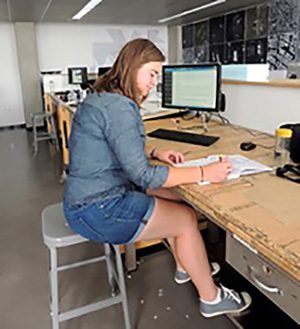
Associate Professor Arijit Sen collaborated with over 10 students on various research projects funded through the UWM SURF program and the McNairs Scholars Program. This research has been disseminated in conferences including the National Humanities Conference in Salt Lake City, The Imagining America Conference, Milwaukee, the Society of Architectural Historians Conference, Glasgow, UK and the Annual Vernacular Architecture Forum Conference in Salt Lake City. In March he spoke about his research “Place acts: Immigrant placemaking in Milwaukee and Chicago,” at the Princeton-Mellon Initiative in Architecture, Urbanism & the Humanities in Princeton, New Jersey.
Below is an abstract from the panel:
Scholars see “place” as an active agent that can transform everyday practices and precipitate equitable social change. Our use of the term place acts refers to place-based storytelling and action research practices that render visible overlooked places, forgotten histories and disregarded people. This roundtable will engage the audience in dialog with 5 panelists who have successfully used place as a central trope in their practice, albeit from different perspectives. An initial discussion, based on actual examples drawn from the participants’ experiences will identify specific methods, best practices, technologies, and techniques of “place acts” in different locations such as New Jersey, Pennsylvania, New York, Texas and Wisconsin. Subsequently a moderated discussion will encourage all attendees to debate the impact of community collaboration by explicitly linking place-based design practices, new digital and social media tools, as well as assessment methods in their respective teaching, practice and grassroots activities.
